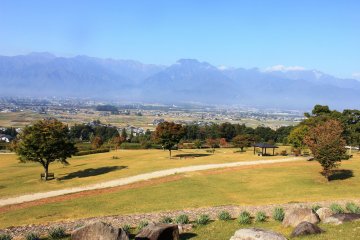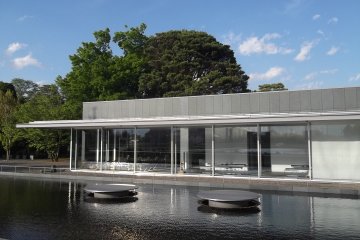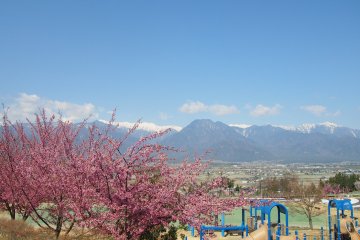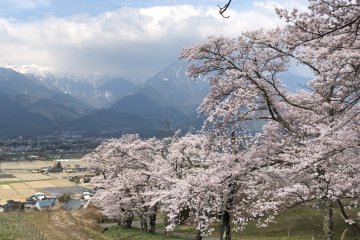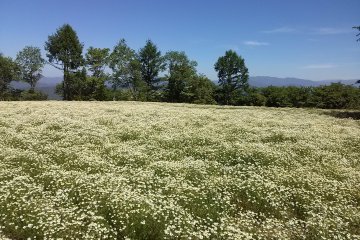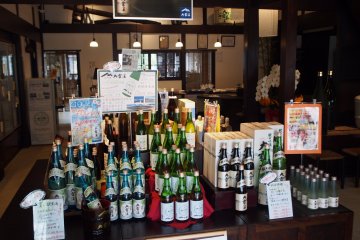Nestled in scenic Nagano Prefecture, less than 200 kilometers from Tokyo, is the small town of Ikeda. With fewer than 10,000 residents, the area is a rural paradise that has been called one of Japan’s most beautiful villages. When searching for a quick escape from the hustle and bustle of the metropolis, you need look no farther.
The beautiful fields of Ikeda contrast with a majestic backdrop—the Northern Alps. These towering ridges, topped with snow until early summer, are a reminder of the powerful forces of nature that gave birth to the islands of Japan.

In spring, delicate pink cherry blossoms blend with distant snowcapped mountains to create a wonderland that is quintessentially Japanese. Stretches of soft purple lavender canvas the rolling hills while fields of white and yellow chamomile splash bright color against lush greenery. When viewed from above, it looks as if someone sprinkled colorful powdered sugar on the landscape.
Sumptuous Sakura
Cherry blossoms (sakura) are one of the most recognizable symbols of Japan. Gathering under the cherry trees to eat, drink, and talk with friends and family is one of the most delightful and anticipated events of the year—a practice that goes back as far as 794, during the Heian period.

The importance of these flowers in Japanese culture stems from Buddhism, and they are a symbol of the ephemeral nature of human existence. Their time is brief, their beauty great, and their appearance coincides with the arrival of spring each year. The image and essence of sakura can be found everywhere in Japan, from art to ice cream to the ¥100 coin and ¥1,000 bill.

Ikeda is home to some of Japan’s most stunning vistas of sakura, and the best time to view them is from mid to late April. Two spots of particular beauty are Uyama no Sakuranamiki (translates literally as “a row of cherry trees”), which is a long walking path that leads to breathtaking views of the Northern Alps, and Rikugo no Yamazakura, which are the wild cherry trees of the Osenkyo Gorge.
Viewed from afar, the rolling hillsides of Osenkyo Gorge look as if they are covered with soft pink cotton that has burst forth from its bolls. It’s a majestic scene reminiscent of the Japan of old, taking you back to a quieter time when life was more connected with nature.
Herb Haven

Cherry blossoms are not the only natural wonder contributing to Ikeda’s springtime beauty. The town is also known for herbs—particularly chamomile and lavender.
From May to June, the daisy-like flowers at Chamomile Village provide a sunny transition from spring to summer. More than 100,000 plants bloom in this spacious area of nearly 133,000 square meters, where you can get lost in a sea of white and yellow while wrapped in the gentle, relaxing aroma of chamomile. You’ll feel as if you are in paradise.

In mid-June, a shift in hue awaits you as an explosion of lavender paints some 40,000 square meters in soft purple. More than eighty varieties of the fragrant herb can be seen, and the annual Dream Farm Lavender Festival takes place from mid-June to mid-July.
And if you’d like to take some herbs home with you, the nearby Ikeda Town Herb Center offers a wide selection of authentic, carefully grown local herbs and products made from them.
Be Creative

After enjoying an escape to nature, you can follow it up with... more nature, but also a variety of activities, at Azumino Ikeda Craft Park. In addition to stunning views of the Northern Alps, this 160,000-square-meter space is home to a museum and a creative hall that hosts live performances. The hall’s elevation is 634 meters above sea level, which is equivalent to the height of Tokyo Skytree.

Within the park are green open spaces, a pond, flower beds, rock gardens, and an outdoor stage. It is particularly beautiful in spring, when more than five hundred cherry trees bloom. There are many types of cherry trees to enjoy, including Yokohama hisakura, hikanzakura, yaezakura, Scidmore sakura, Gifu yamazakura, Oyama sakura, and weeping sakura. Activities available in the area include carpet golf, gateball, and mountain biking. There is also a playground for small children.
Bio Hotel
The nature in Ikeda is so enticing that it attracted the attention of Bio Hotels Japan, a company founded in 2013 by Kazuhiko Nakaishi. His desire was to create an experience for travelers that connected them to nature and highlighted the concept of sustainable living.

There are more than a hundred certified bio hotels in the world, but only three in Japan. Ikeda is home to one of these, Yasuesou. The others are in Hokkaido and Fukushima. If you are coming from a major city, such as Tokyo, Yokohama, or Osaka, Yasuesou offers a great chance for you to extend your day trip into the night, and to discover how much potential Japan has to reconnect our lives with the environment.
Rooms range from ¥16,000 to ¥20,000 per person per night and include two meals featuring all-natural, pesticide- and chemical-free ingredients that are locally grown.
Taste of Tradition

Another delicious Japanese experience that can be had any time of year is a visit to Daisekkei Sake Brewing Company. The name of this brewery, established in 1898, means Big Snow Valley—a fitting description of the majestic and inspiring Ikeda area.
Sake is widely considered Japan’s national beverage, and its production dates from the third century BC. With such a long history, sake has become ingrained in Japan’s customs and traditions. Components that are essential for making good sake are a cool climate, clean water, and carefully cultivated rice—all of which make Ikeda an ideal location for brewing excellent sake.

While Daisekkei does not offer a guided tour, the brewery is happy to accommodate requests to visit its facilities when a staff member is available to conduct a tour. Be sure to contact the brewery at least one day in advance—preferably more—to arrange a guided visit. If you want to see the actual brewing process as well as the facilities, be sure to visit before May or after September. There is also a shop where you can taste and purchase Daisekkei’s products.
Ikeda: Off the Beaten Path
Ikeda is a bit off the beaten path—which is a good thing. A visit is a true escape to the beauty and tranquility of rural Japan. Most of the sites covered here offer parking, and a visit by car can make it easier to get around.
The drive from Tokyo takes about three and a half hours using the Chuo or the Kan-etsu Expressway, and four hours using the Tohoku Expressway.





